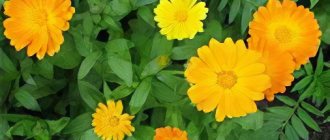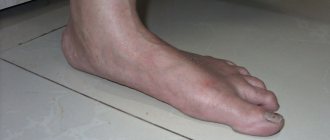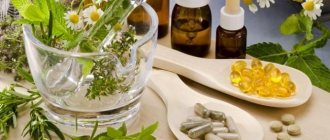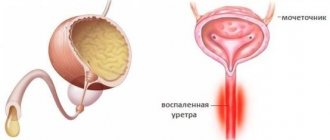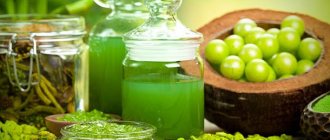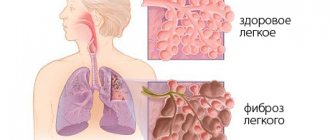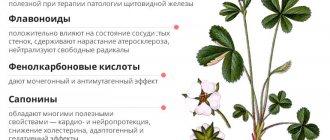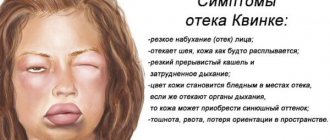Features of treatment with folk remedies
Since the disease does not manifest itself quickly, but over a long period of time, it is very important not to miss the moment of its onset and begin timely treatment.
The disease progresses rather slowly, as a result of which the patient seeks medical help late. The mortality rate in COPD is quite high. Therefore, if there are no serious signs of the disease yet, but even minor symptoms have appeared, it is necessary to carry out diagnostics for the high-quality and effective prescription of all necessary medications.
Traditional medicine has proven itself well in the fight against COPD. There are quite a lot of recipes that have a beneficial effect on the patient’s condition. The main goal of using traditional medicine is to reduce symptoms, promote the removal of mucus from the respiratory tract, and provide oxygen access to tissues.
Many medicinal plants have powerful anti-inflammatory and antiseptic effects, due to which the development of obstruction slows down and affects the destruction of pathogenic microflora. The strategy for treating COPD with medicinal plants has been used for decades, which indicates its high effectiveness. Therefore, the main principles of treating COPD using traditional medicine are:
- treating shortness of breath and cough or alleviating these symptoms;
- stopping the progression of the disease;
- the ability to launch repair processes in the body;
- will increase the patient’s activity and vitality.
Most recipes are used in the form of inhalations. It is enough to breathe in the steam from the decoctions for 10 minutes to expand the lumen in the bronchi and have a positive effect on the ciliated epithelium. Many patients respond positively to the use of medicinal plants in the treatment of COPD.
Spanish moss, moss, heather and many other plants are able to remove thick mucus from the lungs, which causes breathing problems. It is the removal of sputum that many healers place the main importance in the treatment of COPD.
Important! Inhalation should not be carried out during an exacerbation, as this can cause swelling.
Symptoms to watch out for
Let's look at a number of symptoms that you should pay attention to and, if necessary, consult a doctor for a correct diagnosis.
- Often recurrent acute bronchitis;
- Attacks of painful coughing, their number gradually increasing;
- Cough with constant mucus production;
- Increased body temperature;
- Attacks of shortness of breath, which intensifies as the disease progresses.
This disease is considered multicomponent, since several vital organs are exposed to destructive effects at once. More often, this disease develops as a result of smoking, during which irreversible damage to the bronchi and lung tissue occurs. In addition to smoking, the disease can occur due to working in hazardous conditions, systematic inhalation of smoke and due to unfavorable environmental conditions.
At an early stage of development, COPD may not manifest itself in any way. The main symptoms appear later, primarily in smokers. The timing of clinical manifestations is influenced by hereditary predisposition to the disease.
Characteristic symptoms manifest themselves in the form of a dry or wet cough, mainly in the morning. Then, shortness of breath occurs, when breathing first becomes difficult during physical activity, and then in a calm state. With further progression of the disease, breathing is accompanied by wheezing in the chest area.
During the illness, at all stages, an imaginary recovery or remission periodically occurs. At this time, the person begins to feel well, and the disease itself almost does not manifest itself. But after improvements, periods of exacerbations inevitably come. At each stage, COPD treatment is carried out in its own forms and methods.
The initial symptoms are very similar to bronchitis at first. Diagnostics:
- Hoarseness and tickling in the throat;
- Dry, hacking cough. May be more noticeable at night or in the early morning hours. Then a paroxysmal cough with the release of mucopurulent sputum;
- Back pain;
- Weakness, shortness of breath. They appear as the disease progresses. At first, shortness of breath bothers you with the slightest physical exertion, and then even with the slightest body movements. The more the disease progresses, the more the patient experiences respiratory failure.
Treatment with folk remedies
One of the safest and most popular treatment methods is the use of herbs and other natural remedies. However, before using any of them, it is recommended to consult your doctor.
The most effective treatments:
- Flax seeds, linden, chamomile and eucalyptus. It is necessary to take herbs in equal proportions and grind thoroughly using a blender. Pour a tablespoon of the mixture into 250 ml of hot water. Take a glass in the morning and before bed until the symptoms of the disease subside;
- Chamomile, mallow and sage. You will need 5 tablespoons each of chamomile and mallow and two tablespoons of sage. The resulting mixture must be ground in a coffee grinder to a powder state. To prepare the infusion, pour two teaspoons of the mixture with a glass of hot water. Brewing time – 1.5 hours. Take 2-3 times a day for a month;
- Chamomile, sweet clover, licorice root and marshmallow. Dry the ingredients and take them in equal proportions. For half a liter of boiling water you will need two tablespoons of pre-crushed mixture. Infusion time is 20 minutes. After which the infusion must be filtered and drunk in small portions throughout the day;
- Black radish and beets. An effective remedy that is recommended by doctors as a primary or additional treatment. It is necessary to chop beets and medium-sized black radish, add a little water and honey to the resulting pulp. Let it brew for 2-3 hours. Take three tablespoons before each meal. The course of treatment should be at least a month;
- Salt. Inhalation of saline solution helps reduce symptoms of the disease, as well as improve overall well-being. For inhalations, it is best to use special equipment, as well as sea salt. However, you can prepare a hot saline solution and breathe it in while covering your head with a warm towel.
Treatment for exacerbation of COPD
With exacerbation of COPD, symptoms intensify and progress. In this case, the patient’s condition sharply worsens, and usual therapy most often does not help.
If the symptoms of the disease intensify, hospitalization is required - the hospital conducts the necessary tests and applies the necessary treatment methods that cannot be carried out at home. Since respiratory failure develops during an exacerbation, long-term oxygen therapy is prescribed (the patient inhales oxygen-enriched air through a mask).
Bronchodilators and glucocorticosteroids or a combination thereof are also used. If the disease is caused by a viral or bacterial infection, then the use of antiviral agents or antibiotics is required.
We recommend reading: HCG growth is weak in the early stages, what to do
An exacerbation can be caused by any respiratory disease, prolonged physical inactivity, or exposure to harmful factors (smog, smoke). Therefore, patients with COPD need to avoid provoking factors, move as much as possible (since physical inactivity increases congestion in the lung tissue) and perform breathing exercises.
Anti-inflammatory infusion No. 1
To prepare the medicinal collection, you will need dried and crushed chamomile flowers, mallow flowers and sage leaves in equal proportions. The mixture should be placed in a jar and stored in a dark place.
The infusion is prepared as follows:
- 2 tsp. collection must be filled with 1 glass of hot water (temperature 70-80 degrees).
- Then the container must be wrapped and left for 1.5 hours, then strained.
- You need to drink the infusion 3 times a day.
Standard of treatment - drugs and dosages
Chronic changes in the respiratory system are accompanied by damage to individual sections of the bronchi. Gradually, they become overgrown with connective tissue, which leads to irreversible changes. As a result, bronchial obstruction develops, in which the bronchi narrow. When these pathologies occur, treatment of COPD is carried out using combined regimens, used continuously to avoid respiratory failure.
- Bronchodilators increase bronchial patency.
- Exacerbations and swelling are relieved with the help of special drug therapy.
- The patient's serious condition is alleviated by glucocorticoids.
- If bacterial complications occur, antibacterial drugs are prescribed.
- Acute respiratory failure is relieved with oxygen therapy.
Treatment of bronchial obstruction is carried out with the use of bronchodilators introduced into the body by inhalation. Long-acting theophyllines promote bronchial dilation. Reducing side effects is achieved with bronchodilators in the form of formoterol or salbutamol. Delivery of drugs to the bronchi is carried out using aerosol cans, nebulizers and powder inhalers.
Glucocorticoids are prescribed when bronchial obstruction is severe. But their long-term use is contraindicated, since this may cause side effects such as osteoporosis and myopathy.
Before starting treatment and having a positive outlook for the future, you need to quit smoking. It will not be possible to use medications and continue to buy cigarettes, hoping for frequent remissions.
Therefore, if health and life are important to the patient, he should completely give up smoking. Both drug and non-drug therapy are used for treatment
For moderate severity of the disease in adults, the following drugs and dosages are used:
- Mucolytics. They thin the mucus and promote its evacuation (Ambroxol, Trypsin).
- Glucocorticosteroids. Anti-inflammatory drugs (Prednisolone and others).
- Bronchodilators (Seretide, Sembicord).
- Antibacterial drugs for exacerbation (penicillins, cephalosporins).
- Theophyllines. Reduces pulmonary hypertension (Theophylline and others).
- Anticholinergics. Improves lung function (Tiotropium bromide).
Oxygen therapy and massage are also used.
Together with medications, treatment with folk remedies will prolong the period of regression:
- If you take flax seed, eucalyptus, linden flowers and chamomile in equal proportions, you will get a wonderful, effective remedy that can relieve symptoms. Mix all ingredients thoroughly. Then brew a tablespoon of the well-dried and crushed mixture in a glass of boiling water. Let the broth brew for two hours. You need to take the medicine twice a day after meals for two months;
- Nettle roots have long been known in folk medicine as an anti-inflammatory agent that promotes easy mucus discharge and helps get rid of cough. Nettle roots need to be ground in a meat grinder and mixed with sugar in a ratio of 2 to 3. The result should be a homogeneous mass. Then brew the mixture in boiling water. The decoction should sit for five to six hours. You need to take the syrup three times a day. Morning, noon and evening;
- Decoctions from the medicinal plant coltsfoot have an anti-inflammatory effect and have a beneficial effect on the respiratory system. To prepare the medicine, you need to pour a tablespoon of dried medicinal herb with a glass of boiling water and leave for two hours in a thermos. Afterwards, squeeze well. Take the medicine two tablespoons every two hours;
- Black radish mixed with red beets will be an effective cure for the symptoms of the disease. Grind the peeled root vegetables and mix in equal parts. Pour three hundred grams of cooked pulp into a liter of very hot water. Leave for several hours. Take the medicine after meals three to four times a day, four spoons;
- Pour 500 ml of milk into two tablespoons of comfrey. Steam the broth in the oven for five hours. It is necessary to ensure that the medicine does not boil, but remains very hot and steamed all the time. Take one tablespoon three times a day.
Hospital treatment
In case of exacerbation of COPD, a person is offered to undergo inpatient treatment. In this case, oxygen therapy will be the basis, especially if the exacerbation is severe. In this case, spraying of an anticholinergic and adrenergic agonist using a nebulizer is prescribed. Inhalations are carried out every four hours. As soon as the patient feels a little better, the time interval between such procedures increases to six hours.
We recommend reading:
Treatment of pulmonary fibrosis
Bronchodilators are also included in therapy. They are most often used in the form of dry powder or aerosols. In special cases, the drug Aminophylline or Euphyllin may be administered. For purulent sputum, antibiotics are prescribed. And if primary therapy with the use of such drugs does not give the desired result, the drugs are replaced with analogues, but here the sensitivity of the sputum flora itself is already taken into account.
When a person with COPD suffers from soft tissue swelling, the doctor prescribes diuretics. In case of repeated exacerbations, the drug Heparin is added to therapy. If such complex treatment does not give the desired and positive result, the doctor may decide on artificial ventilation of the lungs.The final stage of treatment in a hospital is the use of auxiliary techniques to facilitate sputum production. The patient is also recommended to perform special breathing exercises, which will promote better coughing and removal of accumulated mucus. These same activities can then be used to prevent COPD at home. Sometimes the patient is prescribed vibration massage, which has a similar effect to breathing exercises.
Folk recipes
Anise seeds
The presence of essential oils in the seeds helps relieve spasms in the bronchi, quickly remove mucus and cough up. To do this, you need to pour a teaspoon of seeds into a glass of boiling water, leave the broth for 10 minutes and drink this volume at least 4 times during the day. Use the product before meals. The decoction can also be inhaled.
This is a very useful plant in the treatment of COPD. The drug Mucaltin is made on its basis. Therefore, its use gives positive results. The plant is poured with boiling water and drunk every day before meals in a volume of 100 grams.
Pour 4 tablespoons of herbs into a liter container and pour boiling water over everything. You can use the decoction for inhalation or drink this medicine in a spoon 3 times a day. The course of treatment should last at least a month. The finished mixture is stored in the refrigerator for no more than 3 days.
Milk with fat
You can use badger fat or lard. You need to pour a teaspoon of lard or fat into a glass of milk and boil the mixture for about 5 minutes. Cool and drink 2 weeks before bedtime. Every day the sputum will become lighter and more transparent, and cough problems will also disappear.
Birch juice
Mix 3 parts of birch sap with one part of milk and add a little flour. Mix everything and drink a glass every day for a month.
Iceland moss
20 grams of raw materials are poured into 500 g of water at a temperature of 70-90 degrees and drunk after infusion of the decoction up to 3 times a day, a third of a glass. To enhance the effect, you can add a little honey to the broth.
Pour 200 grams of boiling water over a tablespoon of herbs. Leave for 20 minutes and drink in 3 doses per day.
Black elderberry
Pour a glass of boiling water over the flowers of the plant and leave the infusion for 15 minutes. Drink the mixture up to 4 times a day, a quarter glass.
Grind the comfrey roots, add water and simmer them in a water bath for about 25 minutes. Add hot milk to the mixture, mix everything and drink a spoonful three times a day.
Elecampane and the coltsfoot
You need to take a tablespoon of each herb and pour 250 g of boiling water over them. After an hour, strain and add honey. Drink before meals 3 times a day.
For inhalation, add 5-7 drops of tincture to boiling water, cover your head with a towel and breathe over the steam for 3-5 minutes. Do this procedure until the symptoms disappear.
You can also take pure propolis before meals every day. To do this, chew a small amount of the product for about 20-30 minutes. You can dilute 20 drops of propolis tincture in a glass of hot milk and drink this mixture before bed.
Ginger root has expectorant and antiseptic properties. It improves immunity, cleanses the blood of intoxication, and stimulates sputum production. To prepare, you need 200 grams of crushed product, which is poured with 500 g of vodka. The mixture is infused in a dark place for a week, and then drunk 2 times a day, a teaspoon.
There is no cure for COPD. But the use of folk recipes will allow patients to feel much better and lead a quality lifestyle.
What other herbs are used to treat COPD?
There are many medicinal herbs that are used for diseases of the bronchi and lungs. The following herbal ingredients can be used to treat COPD:
- Thyme - this herb contains a lot of thymol, which has an analgesic and disinfectant effect. A water infusion of thyme is used to treat bronchitis, pneumonia and COPD. Prepare an infusion of 4 tablespoons of herbs and a liter of hot water. You need to drink this mixture one tablespoon before each meal.
- Pansy - this plant contains flavonoids, glycosides and other beneficial substances that help in the treatment of diseases of the respiratory organs. Prepare a decoction from a teaspoon of plant material and a glass of boiling water. Drink ¼ glass of infusion, four times a day.
- Ginger and garlic - these two products help quickly get rid of all the symptoms of COPD . To prepare the healing potion, a small ginger root and a small head of peeled garlic are crushed in a meat grinder. The resulting paste is spread on black bread and eaten twice a day.
You can get rid of a painful cough using a decoction of viburnum bark. Take a tablespoon of plant material, pour a glass of boiling water and leave for an hour. You should drink 50 ml of this decoction during each meal.
There are many traditional recipes for the treatment of COPD, so it is easy to choose the best option. Any folk recipes can only be used in conjunction with drug therapy. Don’t forget about breathing exercises, which help you recover quickly.
Basic moments
COPD is a slow-growing disease. There are many methods by which it is possible to assess the development of a chronic disease in a patient based on the existing symptoms. Initially, a cough with white mucus appears.
There are wheezing, which manifests itself as a whistle or hissing during breathing. The patient also feels acute pain in the sternum, swelling of the limbs and hasty breathing are possible.
The reasons why the disease can develop are as follows:
- use of drugs intravenously;
- immunodeficiency syndrome;
- connective tissue diseases;
- disorders at the genetic level.
The disease can develop over a long period of time. It happens that years can pass between the initial signs of the disease and the final correct diagnosis. During this time, the inflammation gains strength, slowly killing the person. In addition, lung disease is often the cause of death of the patient in itself, since it gives impetus to the emergence of cancerous tumors, which modern medicine cannot yet cope with.
There is also a positive aspect. Treatment methods exist and have been used successfully for years. Although it is not possible to completely overcome the disease, it is possible to significantly improve the patient’s well-being.
Treatment for COPD is aimed at:
- Relieving symptoms (shortness of breath, cough).
- Stopping the development of the disease.
- Launching repair processes in the body.
- Improving the general condition of the patient.
General recommendations to help minimize the impact of lung disease include:
- quitting smoking is the main cause of the development of various lung diseases, COPD is not an exception;
- regular physical activity - walking, breathing exercises;
- rational nutrition is necessary to streamline all somatic processes. You need to monitor your diet, eat a variety of foods, and do not deny yourself food unless indicated by a specialist.
It is important not to abuse antibacterial and homeopathic drugs, they have adverse side effects on the body. https://www.youtube.com/embed/qfjjILzITsg
Oxygen therapy
Long-term use of oxygen therapy for the disease is now considered an effective treatment method. For patients with COPD with established hypoxemia, the use of the procedure increases the likelihood of living for 5-7 years. The effective physiological and clinical effects of oxygen treatment include:
- improvement of general well-being;
- decreased shortness of breath;
- performance promotion;
- decrease in hematocrit;
- increased muscle metabolism;
- reduction of lung hyperinflation.
In addition, this method of therapy increases the presence of oxygen in arterial blood, helping to increase oxygen supply to the brain. Also, treatment with oxygen therapy will reduce lung vasoconstriction and vascular resistance. As a result, stroke volume and cardiac output increase, renal vasoconstriction decreases, and renal sodium excretion increases.
Before prescribing oxygen therapy, the doctor must make sure that treatment of the disease with medications does not bring the desired results and the patient cannot overcome hypoxia. The person complains of constant shortness of breath, and serious complications develop.
The main diseases for which oxygen treatment is indicated include:
- COPD;
- pulmonary fibrosis;
- bronchial asthma;
- tuberculosis;
- sarcoidosis;
- cystic fibrosis.
Chronic obstructive syndrome can be treated with oxygen both in the hospital and independently at home. This method involves adding oxygen to the inhaled air, increasing its content from 20-21% to 24-32%. Oxygen is often supplied through nasal cannulas, from a cylinder, or from an oxygen concentrator.
Treatment with oxygen therapy is prescribed by a doctor for chronic forms of respiratory failure with saturation less than 90%. The required treatment regimen is selected and carried out in a hospital setting under the supervision of pulse oximetry and arterial blood gas composition. Therapy in this case should be carried out continuously (24 hours).
This will improve the patient’s performance and prevent the development of complications.
Like all medications, oxygen treatment must be carried out strictly following the correct dosage. Otherwise, the following side effects are possible:
- Mucociliary clearance is impaired.
- Cardiac output decreases.
- Systemic vasoconstriction decreases.
- Minute ventilation decreases.
- Carbon dioxide is retained.
- Pulmonary fibrosis occurs.
Folk remedies
Treatment of COPD at home using folk remedies is prescribed only in tandem with traditional medicine and if there are no contraindications. As a rule, the following means are used for these purposes:
- Mustard plasters are put on to make breathing easier. It should be emphasized that this method is effective if mustard therapy is applied at the first symptom. In the case when an acute form is observed, the use of mustard plasters is strictly prohibited;
- Warm foot baths help improve respiratory function;
- banks that are placed on the back have proven themselves well;
- to improve sputum discharge, badger fat is indicated, which is used to massage the sternum;
- Propolis is useful. It is used for compresses on the sternum. This beekeeping product is pre-melted in a water bath, then mixed with the juice of white sterling onions. The resulting mixture is rubbed on the sternum;
- Warm milk with butter and honey has a mucolytic effect. It is recommended to drink this drink 3 times a day for a week. It is advisable to use acacia honey to prepare this drink.
Phytotherapy is effective in the fight against COPD. Many herbs have expectorant, antibacterial and anti-inflammatory effects. The most medicinal group includes the following plants:
- pharmaceutical camomile;
- calendula;
- Linden;
- aloe;
- thyme;
- marshmallow
These herbs are used to make medicinal infusions, which are then used in nebulizer devices to inhale healing vapors. If you have doubts about the dosage, you can purchase a herbal mixture at the pharmacy.
It is worth noting that such non-pharmacological therapy can cause harm if an adult has an individual intolerance to one of the constituent substances. Taking this into account, the patient needs to coordinate the use of additional funds from the people's piggy bank.
The most optimal would be the use of modern drugs offered by medicine. At the same time, treatment with these methods also needs to be done under the supervision of a doctor.
Diet for the treatment of COPD
No special diet is required. It is recommended to eat as varied a diet as possible, including vegetables, cereals, fish, meat, and fruits. Since COPD patients often lose weight, it may be necessary to increase their daily calorie intake.
Additional nutrition tips:
- Eat in small portions, but often - take 5-6 meals a day;
- exclude salt;
- drink more water;
- take vitamins.
Herbal preparations and infusions against COPD
Let's consider the most effective of them, which will be able to relieve the patient from painful symptoms and help cope with the disease:
- Take 100 g of sage, 200 g of chamomile and 200 g of mallow. Mix all three components thoroughly, then beat them with a mixer until they are almost powdery. After this, prepare the infusion by pouring boiling water over the mixture at the rate of one tablespoon of the mixture per glass of boiling water. Let it brew for an hour. It is best to take twice a day at any convenient time for two months. After this, you will need to switch to another recipe.
- Take 100 g flax seed, 200 g eucalyptus, 200 g linden flowers and 200 g chamomile. Pre-dry all the herbs, then chop them thoroughly and brew. The proportion is the same - 1 tablespoon per glass of boiling water. You also need to take it twice a day for two months.
- Another recipe can be used to assist drug treatment. This collection will help relieve fatigue and improve the release of phlegm from the body. You will need to prepare 100 g of chamomile, sweet clover, wild mallow, licorice root, marshmallow root and anise berries. Also take 300 g of flax seeds. All these components will need to be thoroughly dried, crushed and mixed. Then brew the mixture with boiling water. For two and a half tablespoons of the mixture, take half a liter of boiling water. Infuse for half an hour, then strain and take in the same way as previous collections.
All of these recipes can also be used in homeopathic treatment. After all, it’s no secret to anyone that traditional methods are much more harmless and do not have mutual conflict, unlike medications. This means that they will not interfere with treatment, but will only facilitate it.
Black radish and beets
Leave it for three hours. The infusion will need to be taken 4 tablespoons three times a day. The course of treatment lasts a month, after which you will need to take a break for at least a week.
Thus, it is quite possible to treat COPD at home without special costs.
Nettle against COPD
In folk medicine, they are used quite often because they help, among other things, remove phlegm, get rid of coughs and relieve inflammation of the respiratory tract. Actually, these are all the symptoms that need to be eliminated when treating COPD.
Grind the nettle roots and mix with sugar in a ratio of 2 to 3 until you get a homogeneous mass. Then infuse the nettle for 6 hours.
The resulting syrup should be drunk three times a day at any convenient time. This is one of the most effective methods.
Using salt
Meanwhile, in recent years, treatment of COPD with salt has found itself as a new method. It can be called folk, since its origins are still there, in folk medicine.
Treatment with mineral salts has long been known and widely used, although it was almost forgotten due to many new drugs.
Meanwhile, inhalation of saline solutions perfectly helps relieve the symptoms of COPD and significantly reduce the impact of the disease on the patient’s life. True, it is not always possible to carry out such inhalations at home.
But it should be borne in mind that it is much better and, quite possibly, more productive to turn to this method, rather than rushing to take expensive medications, which, moreover, have a lot of side effects.
Chronic obstructive pulmonary disease can be treated with folk remedies.
Over the past few years, chronic obstructive pulmonary disease has begun to occupy a special place among all diseases of the respiratory system. People around the world are starting to take this disease more seriously. After all, this disease does not go away without a trace for everyone. Serious complications that arise from the disease in some cases lead to death.
At the moment, to combat chronic obstructive pulmonary disease, not only pharmaceutical drugs are used, but also alternative medicine, which can significantly alleviate the patient’s condition. What do you need to know about this disease?
Traditional Treatments
The most effective method to cure chronic obstructive pulmonary disease is to eliminate the factors that provoke it, primarily smoking.
Additionally, the doctor will prescribe treatment that can slow down the process of lung destruction, as well as significantly improve your well-being.
We recommend reading: Symptoms of sinusitis and treatment with folk remedies
The following drugs are used in the treatment of the disease:
- Mucolytic drugs. Provide dilution of mucus and its removal from the bronchi;
- Bronchodilators. Taking medications expands the bronchi due to relaxation of its walls;
- Antibiotics. Recommended for complications of the disease to relieve inflammation;
- Inhibitors of anti-inflammatory mediators. These drugs inhibit the activation of substances that are responsible for the inflammatory process;
- Glucocorticosteroids. They are hormonal drugs that are used during exacerbation of the disease to relieve an attack of respiratory failure.
Bronchodilators are most often available in inhaled form, which can be used by people of any age, including the elderly. This form of the drug is the safest and does not burden the liver, kidneys and other organs.
An effective treatment method is to attend a rehabilitation program, which helps you learn to stop the attack on your own. The program includes a set of exercises, as well as nutritional recommendations.
In advanced forms of COPD, it is recommended to take courses of oxygen therapy. This is one of the most effective remedies for progressive respiratory failure.
Causes of chronic obstructive pulmonary disease (COPD)
The list of main factors that can lead to COPD and the need for treatment with medications or other available means can include the following items:
- smoking, which becomes the main cause in 80-90 cases out of 100 diagnosed. The mortality rate from COPD among those who cannot give up the bad habit is the highest, as this causes airway obstruction and shortness of breath. In such a situation, treatment is urgently required, which can be carried out at home. If there is no way to go to the hospital, then it is necessary to use at least folk remedies to stop the course of COPD;
- professional factors, primarily interaction with dust containing large amounts of cadmium and silicon. The people most often affected by COPD are those who work in the mining industry, as well as miners and builders who are forced to work with cement mortars. It is in order to prevent the development of this serious disease, and not to carry out treatment with available means later, it is necessary to observe safety precautions, which implies the use of individual and collective protective equipment;
- poor heredity, which has not yet been fully studied by specialists. However, it is already known that a rare hereditary deficiency of α1-antitrypsin, which is responsible for suppressing chemical reactions that occur in the bloodstream with the participation of serine enzymes from the class of hydrolases, acts as a genetic risk factor.
It should be noted that the last factor most rarely leads to COPD.
Recipes for the treatment of pulmonary diseases
First of all, it is necessary to relieve pain, lower the temperature (if any) and ease breathing. Given the severity of the acute period of pulmonary diseases, treatment should be aimed at solving these three problems simultaneously.
The most effective means for this are:
- Rubbing the chest and back with turpentine ointment.
- Wrapping a mesh of fat from the internal organs of animals or rubbing with internal fat.
- Drink plenty of warm herbal infusions based on plants that have an anti-inflammatory effect, mentioned above.
More complex recipes may also be used. Their use will significantly alleviate the condition of a sick person. The most common of them are made from means available to everyone:
- For chest pain from coughing and pulmonary diseases. You can use cottage cheese cake. It is best to heat any cottage cheese in a stove, oven or on a radiator. Place on cheesecloth - a layer of cottage cheese, a layer of honey. So up to 10 layers. Place one cake on the patient’s chest, the other on the back. Wrap a towel over the top, wrap it up, and keep it overnight.
- For a severe cough. Take 2 tablespoons of melted butter, honey, and vodka and mix until smooth. You need to take a teaspoon half an hour before meals three times a day.
- For pneumonia. Grind two aloe leaves, add 12 tablespoons of honey, 4 tablespoons of water. Mix everything and simmer over low heat for 2 hours. Stir, cool. Store in a cool place. Take a tablespoon three times a day.
- To remove mucus from the lungs (for expectoration). Take a decoction of elecampane herb 3 times a day for 3 weeks.
- For bronchitis and pneumonia. Warm up a glass of honey, pour a heaping tablespoon of viburnum berries into it, leave overnight. Take a tablespoon 3 times a day.
People suffering from nicotine addiction or working in hazardous industries can be recommended to take a course of expectorants, and during seasonal exacerbations of diseases, take the anti-inflammatory decoctions and infusions described above. A significant part of lung diseases develops against the background of hypothermia. The use of herbal infusions and other folk remedies, even as a preventive measure, will help avoid many problems.
Decoctions and teas
Various decoctions and teas are also prepared using medicinal plants. Correctly selected recipes significantly improve the quality of life of patients with chronic obstructive pulmonary disease. The most effective of them are the following:
- Mix agrimony herb, birch leaves, burdock root, calamus, thyme, plantain, St. John's wort and chaga in equal proportions. Approximately 2 teaspoons of the mixture should be poured into a liter of boiling water and simmer over low heat for about 10 minutes. Then strain the mixture and divide into 3 equal parts. Drink the decoction every time after meals.
- Boil 20 g of elderberries in 200 ml of water over low heat, leave for 20 minutes. Divide the decoction into equal parts and drink throughout the day before each meal. For better absorption of folk medicine, you can add a teaspoon of honey.
- You need to grind 100 g of sage, 200 g of chamomile and mallow into powder. Pour boiling water over the resulting mixture in the proportion of a glass of liquid to a tablespoon of the mixture. Drink the drink twice a day chilled.
Using decoctions and teas for COPD at home for medicinal purposes is a fairly lengthy process. Therefore, you should not expect a quick therapeutic effect. After about a month of use, the first results become noticeable.
Symptoms and stages of the disease
The most common symptoms of the disease include shortness of breath and cough with sputum production. With the development of lung disease, even minimal physical activity becomes significantly more difficult.
The most characteristic signs of the disease include:
- Cough. One of the very first signs of COPD. Smokers attribute their cough to a bad habit. And if at first the cough is mild and episodic, then gradually it becomes chronic, becoming almost continuous. Most often, coughing occurs at night;
- Sputum. This symptom occurs along with a cough. Sputum is initially released in small amounts. However, in the acute form of the disease, coughing may produce copious and even purulent sputum;
- Dyspnea. Refers to later symptoms of the disease. Shortness of breath may appear years after symptoms first appear. Most often, this symptom occurs during significant physical exertion or acute respiratory disease. In the final stages, shortness of breath develops into severe respiratory failure.
Depending on the severity of the disease, four stages can be distinguished, each of which has its own symptoms:
- First stage. It occurs in a mild form. Most often, patients do not even notice that their lung function is impaired. Among the symptoms, one should highlight a chronic cough, according to which doctors make a diagnosis. However, in the first stage there may be no cough;
- Second stage. The course of the disease in the second stage is of moderate severity. An exacerbation of the disease occurs, accompanied by a severe cough, sputum production and shortness of breath with significant physical exertion;
- Third stage. The course of the disease is characterized as severe. Exacerbations of the disease often occur, shortness of breath increases and turns into respiratory failure;
- Fourth stage. At this stage, the person’s condition deteriorates greatly, and frequent exacerbations become life-threatening. At this stage, severe bronchial obstruction is noted, and the development of cor pulmonale may occur. The fourth stage of the disease leads to disability and can be fatal.
What is COPD and how to detect this disease in time, doctors tell you, watch the video:
Characteristic symptoms of obstructive disease
Symptoms of COPD:
- Irregular wet or dry cough.
- Mucus or pus that accumulates in the upper respiratory tract and is released when breathing or coughing.
- Functional disorders of gas exchange in the body.
- Difficulty breathing or shortness of breath with increased physical activity.
The progressive nature of the course of chronic obstructive pulmonary disease is determined by:
- general weakness of the body;
- hypoxia;
- functional degeneration of lung tissue;
- weakening and disruption of the shape of the diaphragm;
- degradation of the respiratory muscles.
Hypoxia in patients with COPD is most acute during periods of intense physical activity, for example, when running or fast walking, overcoming obstacles, climbing stairs, carrying heavy objects, etc. Exacerbations or particularly severe forms of chronic obstructive pulmonary disease can cause the inability to move independently without the help of relatives or hospital staff. A history of COPD quite often includes drug addiction or smoking, acute respiratory diseases, seasonal pulmonary inflammation, occupational intoxication or exposure of the patient to harmful gases or dust particles. As a rule, almost all parts of the lungs are affected, as well as the blood vessels that penetrate the lung tissue.
The need for surgery
At the most severe, or fourth stage of COPD development, drug treatment of the disease is no longer enough. At this stage, a decision is often made about the need for surgical treatment. This helps to at least slightly improve lung function and reduce painful symptoms when drug treatments no longer give the desired result.
In cases of severe pulmonary emphysema with severe shortness of breath, purulent sputum, and hemoptysis, bullectomy is used. This operation reduces shortness of breath and improves lung function. In addition, surgical treatment methods such as:
- Surgery to reduce lung volume (reduces shortness of breath during the slightest physical exertion, for example when getting dressed or trying to walk a few meters);
- Lung transplantation (a radical treatment method that allows a patient with COPD to return to an almost full life).
After surgical treatment, a rehabilitation period begins, during which the person enters a stage of stable remission and returns to everyday life. It includes sanatorium treatment, as well as physical and social adaptation to a full life.
